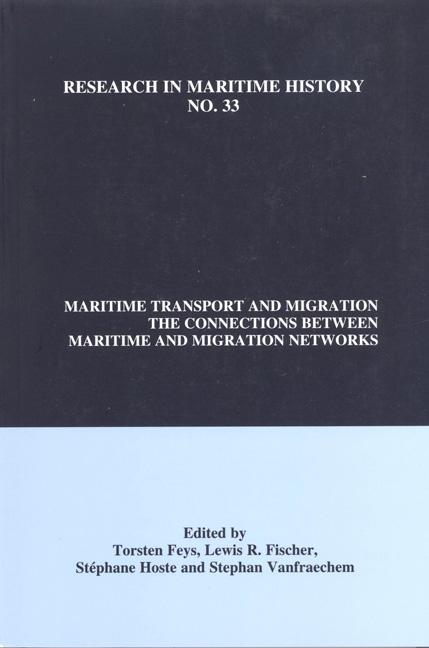Book contents
- Frontmatter
- Contents
- Contributors' Notes
- “Migration and Maritime Networks in the Atlantic Economy: An Introduction”
- “The First Waves of Internationalization: A Comparison of Early Modern North Sea and Nineteenth-Century Transatlantic Labour Migrations”
- “The Battle for the Migrants: The Evolution from Port to Company Competition, 1840-1914”
- “The Role of Foreign-bora Agents in the Development of Mass Migrant Travel through Britain, 1851-1924”
- “Transatlantic Emigration and Maritime Transport from Greece to the US, 1890-1912: A Major Area of European Steamship Company Competition for Migrant Traffic”
- “The ‘Relatives and Friends Effect:’ Migration Networks of Transatlantic Migrants from the Late Habsburg Monarchy”
- “Crossing the Last Frontier: Transatlantic Movements of Asian Maritime Workers, c. 1900-1945”
- “Costs, Risks and Migration Networks between Europe and the United States, 1900-1914”
- “Conclusion”
“The Battle for the Migrants: The Evolution from Port to Company Competition, 1840-1914”
- Frontmatter
- Contents
- Contributors' Notes
- “Migration and Maritime Networks in the Atlantic Economy: An Introduction”
- “The First Waves of Internationalization: A Comparison of Early Modern North Sea and Nineteenth-Century Transatlantic Labour Migrations”
- “The Battle for the Migrants: The Evolution from Port to Company Competition, 1840-1914”
- “The Role of Foreign-bora Agents in the Development of Mass Migrant Travel through Britain, 1851-1924”
- “Transatlantic Emigration and Maritime Transport from Greece to the US, 1890-1912: A Major Area of European Steamship Company Competition for Migrant Traffic”
- “The ‘Relatives and Friends Effect:’ Migration Networks of Transatlantic Migrants from the Late Habsburg Monarchy”
- “Crossing the Last Frontier: Transatlantic Movements of Asian Maritime Workers, c. 1900-1945”
- “Costs, Risks and Migration Networks between Europe and the United States, 1900-1914”
- “Conclusion”
Summary
Introduction
The importance of information flows for migration and shipping has been discussed by both maritime and migration historians. Among the former, John Gould's theories about the impact of “diffusion” and “feedback” on patterns of European inter-continental migration have been particularly important. Successful pioneers in the nineteenth century stimulated migration through letters and remittances, establishing “chain migration” patterns involving both kin and others from local areas. The spread of information and technological evolutions in transport and communication lowered the psychological fear of migration. Gould's work inspired migration historians to shift their focus from the nation to more localized regions, in the process uncovering the fact that the “path dependency” of migrants in their quest to reduce uncertainty was often based upon choices made by previous emigrants. But Dudley Baines has argued that the emphasis on chain migration may overestimate the importance of such networks, especially since migrants who moved outside these structures are much harder to trace and hence more difficult to understand. Moreover, these studies have too often simplified the concept of chain migration by failing to consider the dynamics of networks and by ignoring recruiting and government agents. As well, the impact of newspapers, governments and transport companies on providing information about opportunities to relocate has received little attention from migration historians.
To make a bad situation worse, migration scholars have failed to integrate their work with the studies of maritime historians. While this has hindered our understanding of the impact of maritime networks on migration, it is also the case that few maritime scholars have considered migration patterns and their networks. For example, research on passenger liners has failed to link the companies to chain-migration patterns because it has tended to ignore the strategies that shipping companies adopted to attract migrants. Such tactics were strongly influenced by intense competition among shipping companies that led eventually to the introduction of conference agreements between major passenger lines. Among other things, these conferences supported inter-firm learning and sustained growth. Moreover, most studies with a maritime focus have examined only a single company; on a broader scale, only the Anglo- German-American rivalry has received much attention.
- Type
- Chapter
- Information
- Maritime Transport and MigrationThe Connections Between Maritime and Migration Networks, pp. 27 - 48Publisher: Liverpool University PressPrint publication year: 2007



